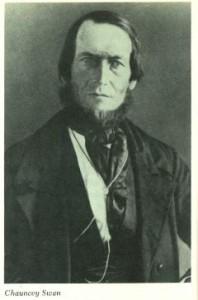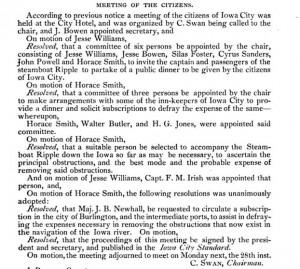Posted by Anne M on Monday, May 2, 2016

Chauncey Swan is not, as I thought when I moved here, a species of water fowl. (I know, I know, but I’m not an ornithologist.) He is also not two people; there is no Mr. Chauncey. He is one man, a founding father of Iowa City. He was one of three appointed by the territorial governor (Robert Lucas) to determine the location of the capital of the new Iowa territory. It should be noted that Chauncey Swan deserves the most credit of the three men as he was acting commissioner for the survey, reported back to the legislature, and Robert Ralston was three days late and didn’t really help at all. It should also be noted that they chose the site of Iowa City on May 1st, 1839. It wasn’t really official until May 4th because they were waiting for Ralston. So, a Happy Chauncey Swan Day to you!
Weber writes in his Press-Citizen column (2/9/79) that “No name [Swan] stands out as consistently and prominently in early history, and always in vital, worthwhile projects with strong overtones of moral character.” Sounds wonderful, but what were these “vital,” “worthwhile,” and “moral” projects?
Politician and Overseer of Mail

Well, we know he was a politician (Democratic-Republican). He was appointed to decide the capital because he served in the House of Representatives for the Iowa Territory in 1838. He represented Dubuque County. Before he pioneered to Iowa, he served as postmaster in Otisco, New York and was appointed to that post by President Andrew Jackson. Postmasters, like most government positions at the time were political appointments and the only real requirement for these jobs was that you were a loyal member of the party. A decade later, he was back with the United States Postal Service, serving as the third postmaster for Iowa City (1839-1841; appointed by President Martin van Buren). Swan left Otisco for Dubuque in search of lead. On February 3, 1838, he made that “fine discovery of lead ore.” (Briggs).
Old Capital Constructor
Swan oversaw the construction of the Old Capital building (he wasn’t the architect, but the superintendent). Again, politics are always wrapped up in everything. According to an 1841 report to the Iowa legislature, as superintendent of public buildings in the new capital, Swan states that he paid $600 for the finest oak for the flooring of the building (Aurner, 125). Who was this paid to? John Ronalds. Ronalds was the third man in the party to determine the location of the new capital. He was the one that wasn’t late, depending on what source you read. He might have been an hour late (Randak).
President of Grist Mill
In the spring of 1843, there was a meeting presided over by Judge G. Coleman to consider building a dam on the Iowa River for a grist mill. A stock company was formed and the Iowa City Manufacturing Company was started. The president of this company? Chauncey Swan! The company owned three acres of land for the mill and four miles of water rights. They began advertising in the local paper for wheat to grind in December of 1843. Unfortunately, in 1844, the company failed and it's property put up for auction. (History of Johnson County). Of course, this wasn't the end of the grist mill.
Keeper of Inns
Swan was also a keeper of an inn. In Aurner’s notes, he quotes the diary of T.S. Parvin as “Stopped at Swan’s, the only good tavern ever established in Iowa (5/31/1842)". Aurner also mentions that the Masons often visited Swan’s hotel and “partook of a dinner in his best style.” Probably the most important dinner to take place at Swan’s Hotel occurred on June 14, 1841. It celebrated the first steamboat (the Ripple) to arrive in Iowa City. Swan was appointed to oversee the festivities.

I’m not entirely sure when Swan Hotel stops being Swan Hotel. In a newspaper article from 1939 discussing the early hotels of Iowa City, it states that the inn became the Morris Hotel in 1847, but Swan references the hotel in his 1849 letters published in the Iowa Journal of History as his son taking over as proprietor (see below). Weber writes that the hotel stood on the northeast corner of Jefferson and Capital Streets and overlooked the Iowa River (Weber, Historical Stories, v.6).
An article in The Palimpsest by Ruth A. Gallaher states that the parody song, “Hummer’s Bell,” was composed at the bar in Swan’s Hotel, but no date as to when the song was written. The song made fun of Rev. Michael Hummer, a former reverend for the First Presbyterian Church, who stole the church's bell, but not until 1848. Incidentally, two things stand out to me in this story. One, Chauncey Swan was a member of the Sons of Temperance (Far West Division no. 4), so is interesting that he had a bar in his hotel (History of Johnson County, 408). And Swan was also a founding member of the Presbyterian Church and was probably greatly affected by the bell theft.
’49er
Like many other Americans, Chauncey Swan set out to California to find gold in 1849. However, the troup of Iowa Citians with gold fever decided to organize and found the Iowa City Argonauts (or the Sacramento Mining Company). By working together, the group was able to raise a decent amount of capital to purchase the needed supplies and would travel together, making the journey west safer (Ressler). The party left by wagon train on May 6th, 1849. You can read the letters of his journey in the January 1949 issue of the Iowa Journal of History. In one letter (7/27/1849), he writes his wife that Fort Des Moines is so fine that the state commissioners should have chosen it as a capital—not Iowa City. The capital moved to Des Moines in 1857.
Swan was not happy and particularly unimpressed with San Francisco. He writes that “he cannot find a man here I know among 50,000 souls” and that “it is no place for me in this City (4/25/1850).” According to Irving Weber, Swan wrote on July 27, 1851 that he was coming back as soon as “he could accumulate enough money to book passage home (Weber, 1976)." Weber states that he died as his ship entered New

York Harbor and was buried at sea.
You can learn more about Chauncey Swan and Iowa City history at the Iowa City Public Library. If inclined, there is an article in the third volume of The Palimpsest that lists all the heights and weights of our first territorial representatives! You can check out our local history section, our Digital History Project, and our other digital resources, such as Ancestry.com and Newspaper Archive. Happy Chauncey Swan Day!
Sources:
Aurner, Charles Ray. Leading Events in Johnson County. Cedar Rapids: Western Historical Press, 1912.
Briggs, John Ely. “A Commonplace Calendar.” The Palimpsest. v.19, no. 2 (February 1938): 69-72.
Gallaher, Ruth A. “Hummer’s Bell.” The Palimpsest. v. 3, no. 5 (May 1922): 155-164.
History of Johnson County, Iowa, Containing a History of the County, and Its Townships, Cities and Villages from 1836 to 1882. Iowa City, 1883.
The Iowa Legislature. Legislatures: Chauncey Swan. https://www.legis.iowa.gov/legislators/legislator?ga=-8&personID=16524
Randak, Leigh Ann. "Swan, Chauncey" The Biographical Dictionary of Iowa. University of Iowa Press, 2009. Web. 2 May 2016
Ressler, Theo. C. “Across Iowa in ‘Forty-Nine.” The Palimpsest. v.55, no. 1 (January/February 1974): p. 2-17.
“Recreation Centers: Iowa City’s First Inns Formed Background for Social, Political Events.” Iowa City Press Citizen. July 1, 1939, pg. 37. Accessed through Newspaper Archive.
Swan, Chauncey. “Letters of a Forty-Niner.” Ed. by Mildred Throne. Iowa Journal of History. v.47, no.1 (January 1949): 63-77.
Walker, A. B., “1923 Letter from A.B. Walker to Rev. Robert Reed regarding church property,” Digital History Project, Iowa City Public Library, accessed May 1, 2016.
Weber, Irving. “California Fever start of Ressler Century Farm.” Iowa City History: a collection of columns appearing in the Iowa City-Press Citizen beginning January 22, 1973. Reproduced from the Iowa City Press Citizen. 6/23/1976.
______. “Early Day Iowa-Citians left their marks on city.” Iowa City History: a collection of columns appearing in the Iowa City-Press Citizen beginning January 22, 1973. Reproduced from the Iowa City Press Citizen. 2/14/79.
______. "Chauncey Swan: "Father of City." Historical Stories About Iowa City. v. 6. Iowa City: Lions Club, 1990 (pages 21-24).


Looking for a back to school college mystery? How about a modern mystery inspired by Agatha Christie? "The Truants" would fit the bill! Jess chose her college to study under Dr. Lorna Clay and is amazed and honored that the professor takes a shine to her. She also feels like she has found a place at school with a new group of friends. But of course, there are secrets. And things get complicated. And then someone goes missing...Great read for a fall night. -Anne M